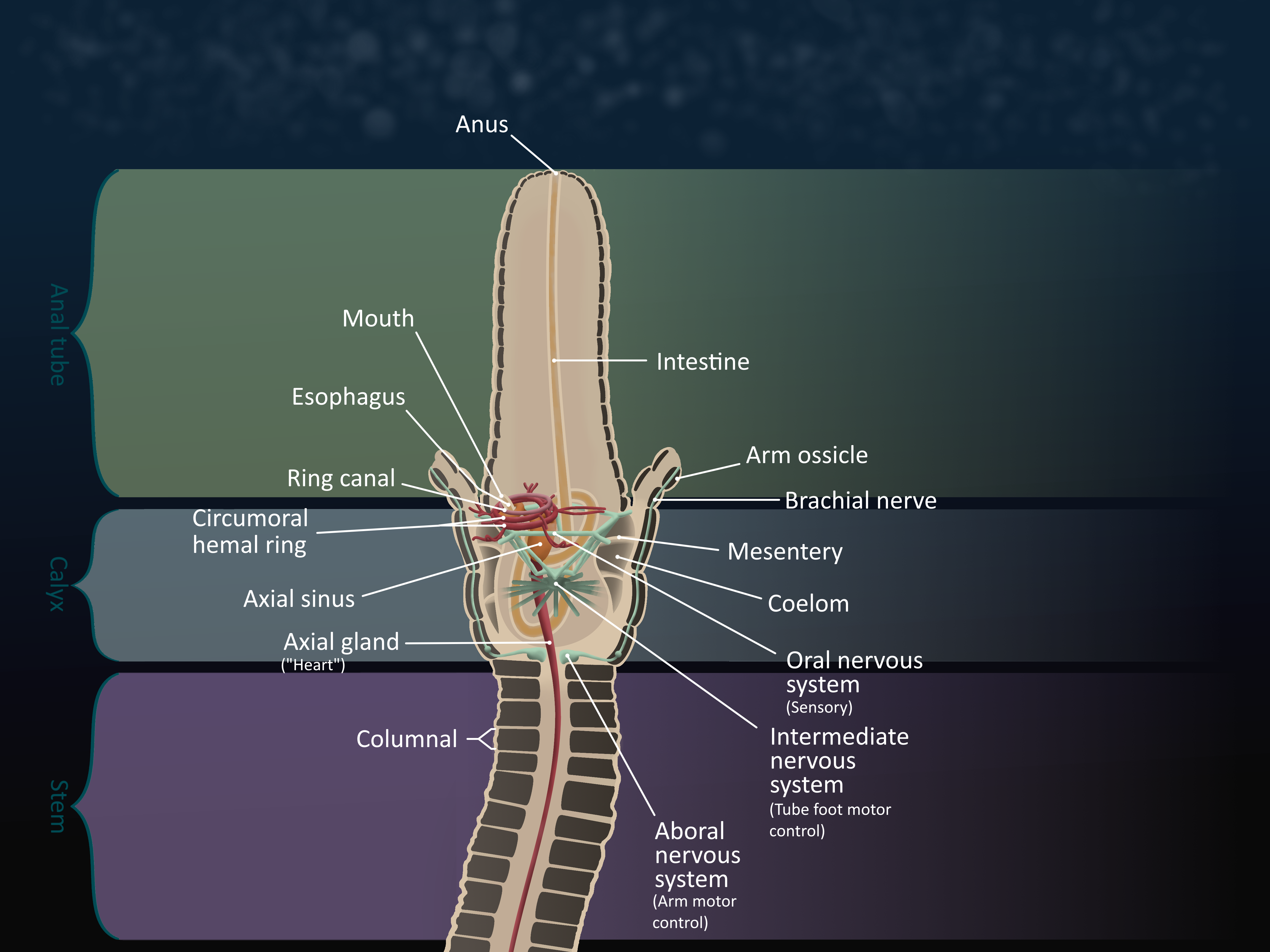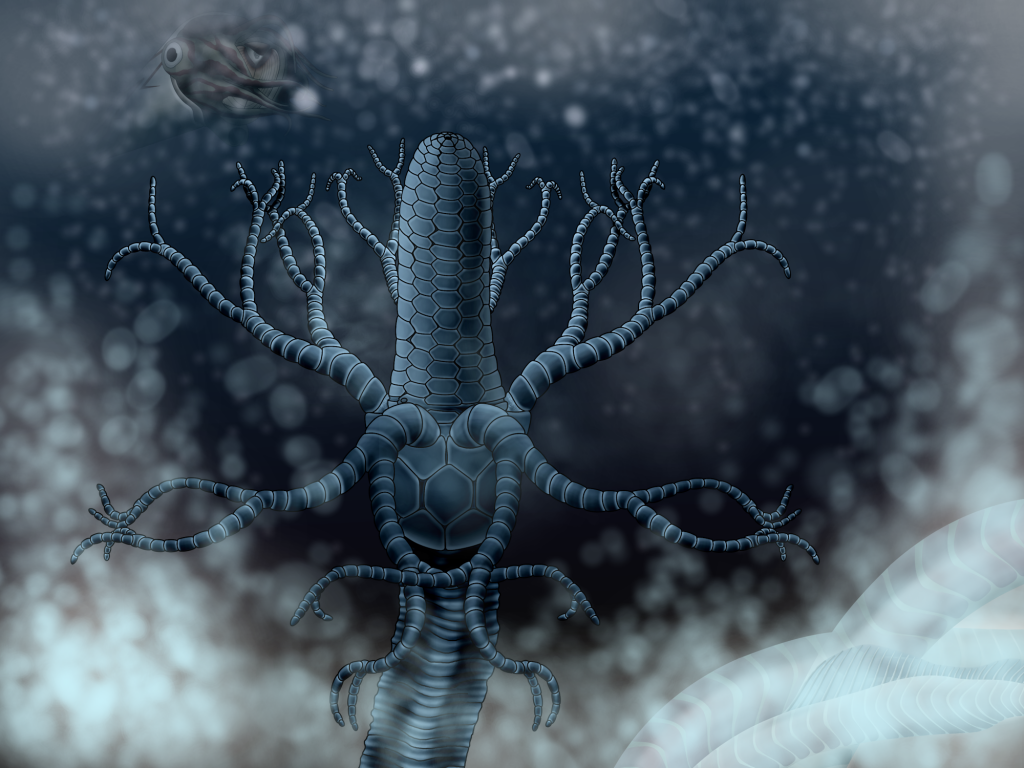
Crinoids were enormously successful Echinoderms that lived all over the world, starting in the Cambrian and living on today with roughly 80 species (1). Their columnals, sections of their stems, preserve especially well as fossils, and their filter feeding habits enabled them to thrive in a plethora of marine environments.
Crinoids found at Seven Stars
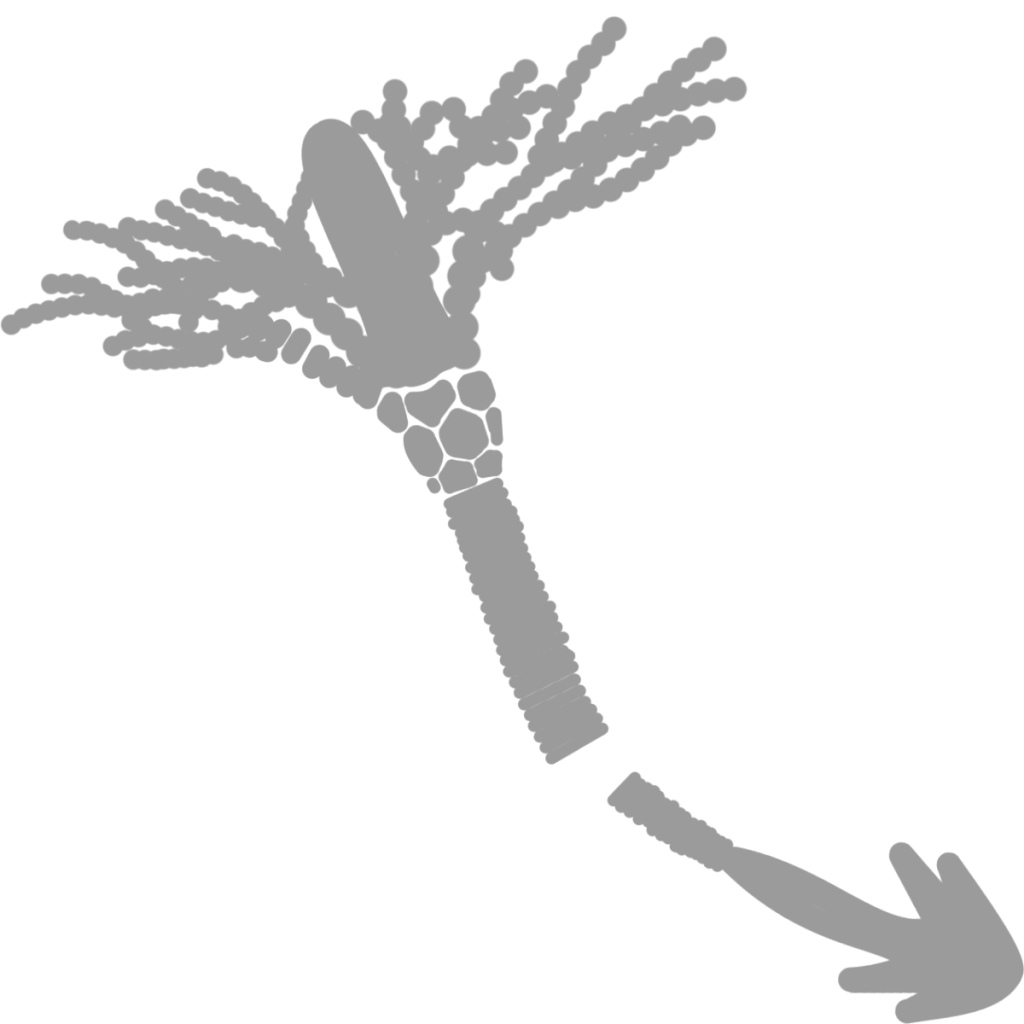
Ancyrocrinus bulbosus
RARE
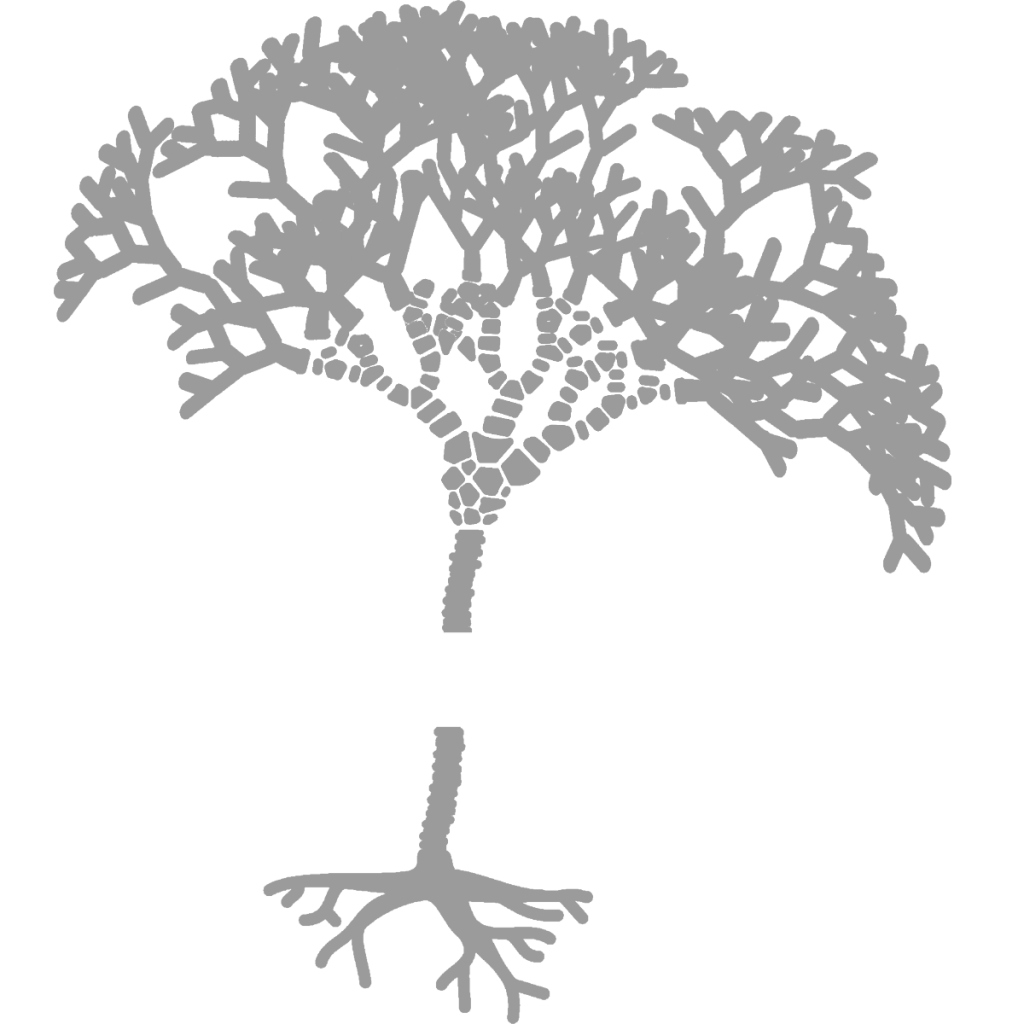
cf. Botryocrinus bellensis
VERY RARE?
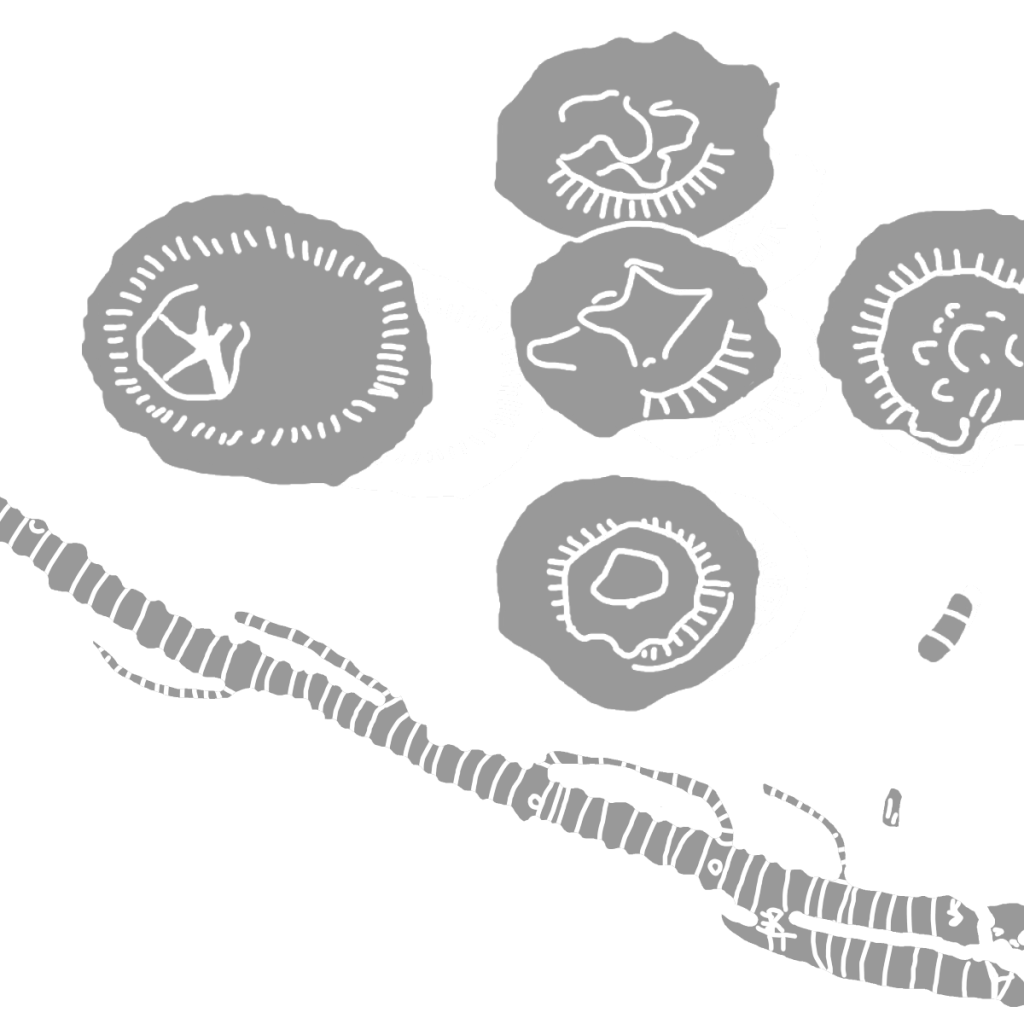
Crinoidea indet.
COMMON
How Do I Identify Crinoids?
Crinoids are among the easiest fossils to identify from other major groups, but identifying them further can be much more difficult. In some layers of Seven Stars, many small, grooved discs are obvious on the rock surfaces. These are individual Crinoid columnals, sometimes covering the entire upper side of the rock (Fig. 1A). Sometimes, articulated crinoid stems are found (Fig. 1B, 1C). These are formed by many columnals stacked on top of one another, and can be mistaken for cephalopods if not inspected more closely.
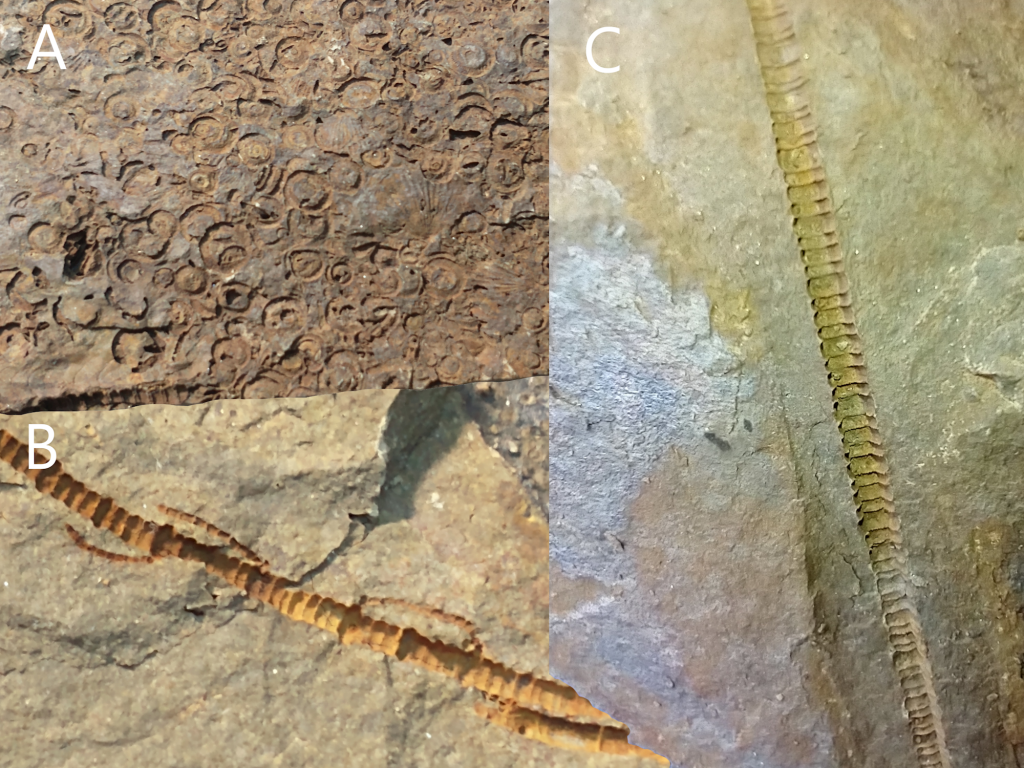
What are Crinoids?
Crinoids are Echinoderms, like echinoids (sea urchins), asteroids (starfish), blastoids, for a few other examples (1, 2). Like other Echinoderms, Crinoids had five-point symmetry around a central mouth. This, unlike other Echinoderms, was directed upwards on the dorsal side of the body, or calyx (1), meaning that Crinoids lived upside-down and that their stem projected from their back.
Crinoids, like all Echinoderms, have a skeleton made up of many hard, internal plates, called ossicles, covered in skin (1, 2, 3, 4). This makes them one of the only groups, other than vertebrates, to have an endoskeleton. The body is further supported by fluid-filled chambers inside the body, called coeloms (2, 6). Walls called mesenteries divided the coeloms and suspended the main body in fluid (2, 6). This increased the stability of the calyx.
The entire Crinoid was covered in tough ossicles, including the arms (1, 2, 3, 4, 6). These were articulated and would first appear very flexible, but it is unclear whether Devonian Crinoids possessed the musculature required to move their arms in the fashion of modern stemmed and non-stemmed Crinoids. Instead, it is likely that extensive ligaments kept the arm ossicles together, decreasing the amount of control the Crinoid had over the positions of its arms (2).
None of the Crinoids from Seven Stars are pinnulated. This meant that they did not bear the feathery extensions emanating from their arms that many modern Crinoids do (3, 4), only making use of the universal tube feet that all Echinoderms have (2). Because they lacked pinnules, it has been suggested that these Crinoids had extra-large tube feet, to increase the surface of their arms and thus the efficiency of the filter feeding apparatus that they represented (2). However, there is no direct evidence of this.
The exact diets of Crinoids are a mystery, other than that they survive on plankton that is filtered out of the water by the arms (1). Once the tube feet, adhesive extensions of the hydraulic system that all Echinoderms use, have captured plankton from the current, they pass it down along a central groove on the upper surface of each arm, called the ambulacral groove (1, 2, 6) (see Fig. 1). These groves work their way down the arms until they reach the upper surface of the calyx (1), called the tegmen. This area has weaker ossicles than the rest of the calyx and protects the digestive system (1, 2). The grooves continue, joining together and using cilia to push the plankton into the mouth, which is offset from the center of the tegmen in Seven Stars Crinoids. The food makes its way through the looping digestive track, and waste is excreted in the form of mucus-covered balls through a tall, plated projection on the tegmen, called the anal tube (1). This ensures that none or very little of the waste will be collected again by the arms and ingested.
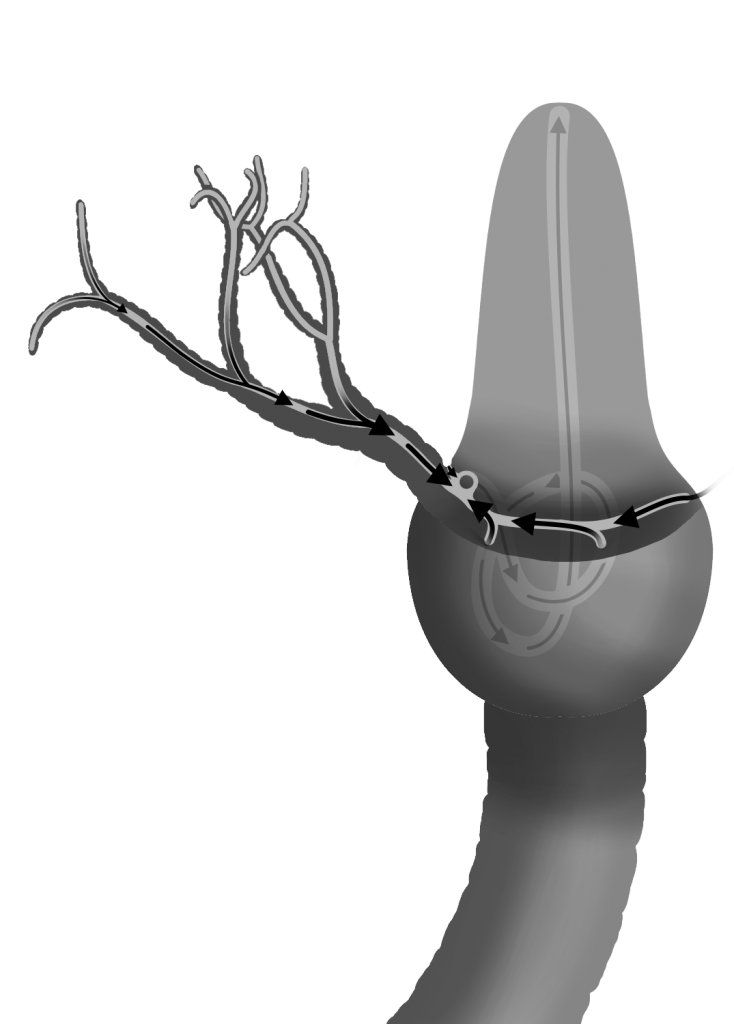
As mentioned above, Crinoids were protected by variously shaped plates called ossicles. The arms held Brachials, and the stem was supported by columnals (2, 3, 4). The calyx, however, was more complicated. Nearest the bottom, where the stem was connected, were Infrabasals (2, 3, 4). Above these were Basals, and above these the Radials. Between two Basals and under the Radials was Radianal plate, bordering the first Anal (2, 3, 4). This plate looked similar to a Radial, but more continued up the Anal tube, protecting it. The radials supported the arms, which were protected by Brachials (2, 3, 4).
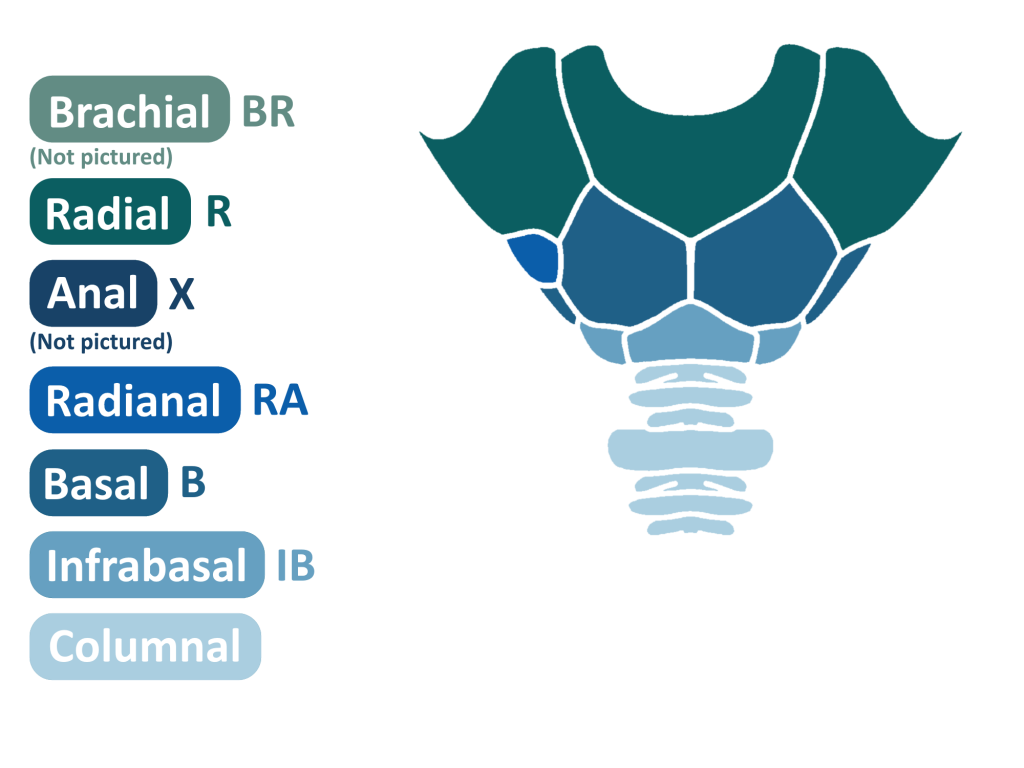
Paleozoic Crinoids and Platycerid Gastropods have a long and well-known history of parasitism (7). Platycerid Gastropods are often found as fossils sitting on the tegmens of Crinoids, presumably taking advantage of their effective filter feeding system. While for a long time it was suggested that the Gastropods were feeding off of the waste the Crinoid excreted, there is evidence that suggests a more harmful relationship for the Crinoid. Bored holes are sometimes found in the calyxes of Crinoids, and one was found with a Platycerid Gastropod lying directly above it (7). This fossil quite possibly represents the creator of the rupture in the Crinoid’s ossicles. Studies estimating how much plankton a pinnulated Crinoid filters and the caloric value it gains suggest that at least pinnulated Crinoids could sustain both themselves and a parasitic Gastropod. Unsurprisingly, Crinoids with Gastropod parasites never grow as large as others of their species, because the Gastropod constantly either consumes the Crinoid’s tissues or inserts mouthparts into its gut to steal food; giving less energy to the Crinoid with which to grow (7).
It is possible that one Crinoid calyx from Seven Stars, attributed to Botryocrinus bellensis, has such a hole between two of its radial plates, but this would be very difficult to confirm. Botryocrinus was not a pinnulated Crinoid, so it may not have been able to filter as much plankton out of the water (4). Yet again, the fossilized calyx is quite small, possibly because it had depleted caloric intake (7).
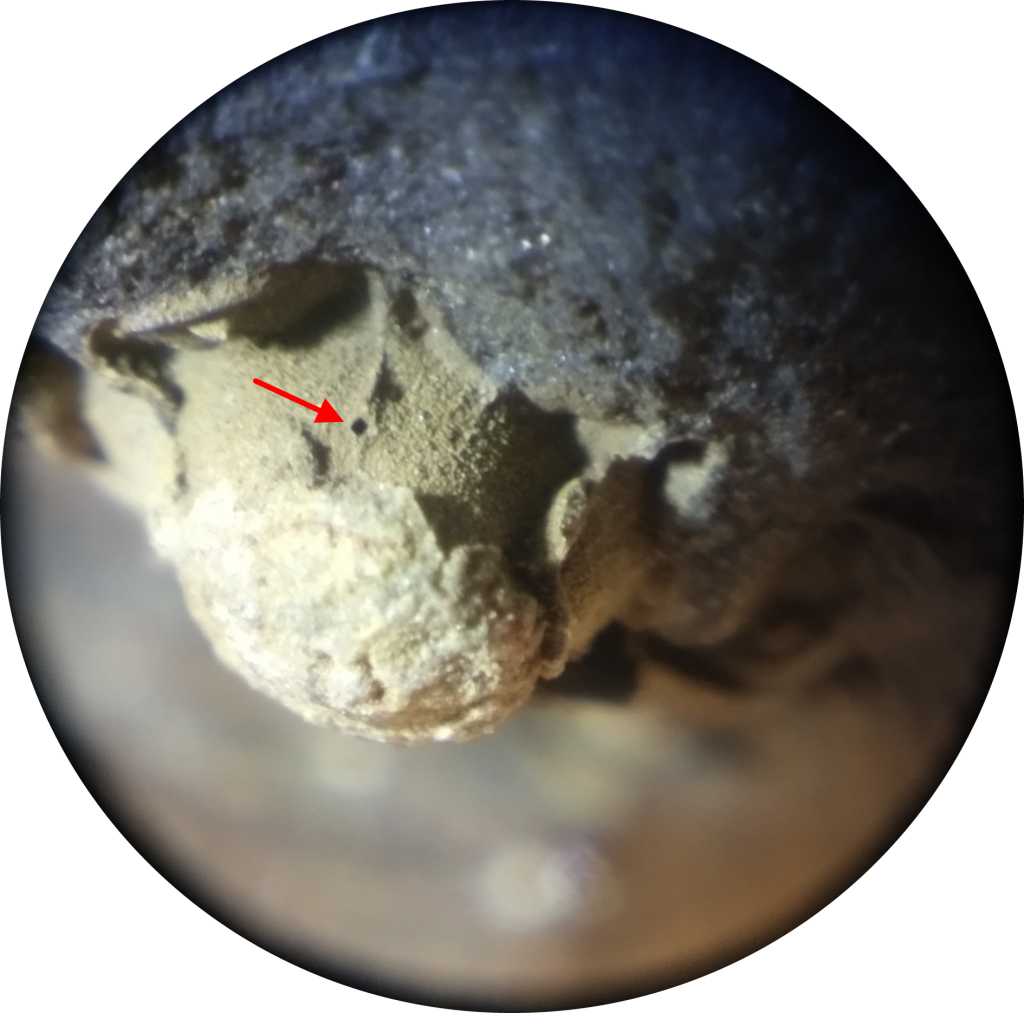
Both confirmed genera of Crinoids found at Seven Stars, Ancyrocrinus and Botryocrinus, were Botryocrinidids, having roughly the same structure of calyx (3, 4). However, Ancyrocrinus was different from all other Crinoids, and its calyx reflected this. While it had the regular five-point symmetry in its upper calyx, some plates were enlarged so that only four infrabasal plates fit on the bottom edge of the calyx, which gave way to a four-sided, unusually stiffened stem (3). At the base of the stem, the columnals began to fuse together, and a slightly striated outer layer (5) covered them. Four (or sometimes more) cirri, which in most Crinoids are small, flexible versions of the larger organism, jut out, forming what is called a grapnel (2, 3, 5). This anchor-shaped section of the lower stem was connected to a traditional Crinoid holdfast while still developing but broke off at an adolescent age (3, 5). The broken part of the stem was grown over by the same outer covering that the rest of the grapnel, in most cases becoming a smooth, round, half-sphere at Seven Stars. Sometimes in Ancyrocrinus, the grapnel rested on a hard surface and the bottom of the bulb was flat, because the hard substrate prevented it from projecting further down (3).
Ancyrocrinus’s method of attaching itself to the seafloor is unlike almost all other Crinoids; only some other structures are similar, in unrelated species. A biomechanical study, by Roy (2014), using models of the grapnel, stem, and calyx shows that Ancyrocrinus couldn’t sustain the traditional theory of attachment, which involved the Crinoid dragging its grapnel on the seafloor to slow its movement with the currents. They also showed that if Ancyrocrinus had a similar mass to modern stemmed Crinoids, then it would have been too heavy to float around high in the water column as others hypothesized. This theory saw the grapnel as ballast, to keep the Crinoid oriented the right way up (5).
This left one major theory, that the grapnel was buried in the seafloor to anchor the Crinoid in one place. Roy (2014) used tanks of water, with differing seafloor sediment including fine quartz (sand), pure kaolin mud, and coarse carbonate sand, according to the kinds of sediment Ancyrocrinus would have lived in, and his Ancyrocrinus models. His findings showed that the grapnel of Ancyrocrinus penetrated the soft mud with very little resistance but had much more trouble in sand. However, if the Crinoid was rocked in the current, thanks to its stiff stem, it could be submerged in sand. Once the grapnel was submerged in sediment, it held against strong uprooting forces. If the Crinoid was uprooted, its falling velocity was more than sufficient to submerge it again in mud, but sand presented more of a problem. The grapnel, as mentioned above, did very little when it was simply dragged across the substrate (5).
Crinoids had more complex central nervous systems than other Echinoderms, with two other branches than their relatives (1). The highest in the calyx, the Oral nervous system, was sensory in function (1). This formed a pentagonal structure, as with the rest of the calyx (excepting Ancyrocrinus) with nerves splaying out to each arm (9).
The second branch was the Intermediate nervous system, which was connected directly to the Oral Nervous system by a central bulge (9). This branch was composed of many radiating nerves (9), which controlled the movements of the food-collecting tube feet, found on the arms (1).
Below the Oral and Intermediate nervous systems, a ring of nerves ran around the Axial gland (or “heart” of the Crinoid), near the base of the calyx, but had radiating nerves feeding into channels in the ossicles (6, 8, 9). These nerves continued into the brachials and controlled the movements of the arms themselves (1), though as mentioned above, Devonian Crinoids may not have had much control of their arms and simply let them wave in the current or held them stiff with ligaments (2).
Crinoids, like all Echinoderms, had hydrocirculatory systems called the Hemal system. This pumped water around the Crinoid, as well as delivered nourishment and removed harmful chemicals (1). The Axial gland functioned similarly to a heart, pumping water through the stem and multiple ring-shaped tubes with radiating off-shoots that supplied the arms and tube feet with Hemal fluid (8).
Crinoids at Seven Stars
While the calyxes of Crinoids are rare finds at Seven Stars, their columnals are much more common. As some of the few filter feeders high in the water column, they had an advantage over the lower-level filter feeders such as corals and lophophorates such as Brachiopods, Hyolithids, Tentaculitids, and Bryozoans. They provided anchoring sites for many other organisms, such as Brachiopods and Gastropods, and would have been obvious when present.
Ancyrocrinus bulbosus
Ancyrocrinus, as mentioned above, is known for its unique anchoring apparatus, visible in the pictures at right. This Crinoid grew considerably larger in the Mahantango Formation than in other formations it is found in, its grapnel growing to a couple inches long. The calyx of Ancyrocrinus is so far unknown from the site, but its arms, unusual square columnals, and easily recognizable grapnels are sometimes found. The best place to search for Ancyrocrinus is the western portion of the site, on the piles above the steeper slope.
(A) Two fossilized arms of Ancyrocrinus bulbosus, with their counterpart. (B) Two columnals of A. bulbosus, as well as other fragments that appear to belong to a crinoid. (C) A large A. bulbosus grapnel, preserving the hardened shaft, the broken bases of the cirri jutting out, and the round protuberance on the end of the grapnel.
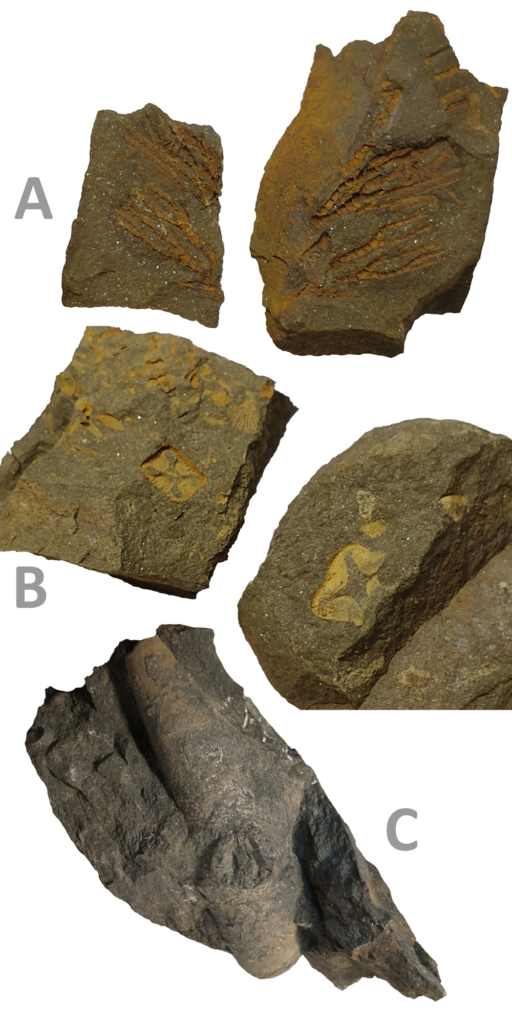
Botryocrinus bellensis
Botryocrinus is harder to find at Seven Stars than Ancyrocrinus, because it had no large grapnel. Instead, it had a likely root-like base with cirri radiating out to grab onto hard objects. Botryocrinus had a calyx that widened quickly, unlike that of Ancyrocrinus. Its arms had a different, alternating branching pattern, and its columnals were star-shaped. Only one confirmed Botryocrinus calyx has been found at Seven Stars. To the right are an arm displaying its branching pattern, a mostly articulated calyx, and a star-shaped columnal from this species.
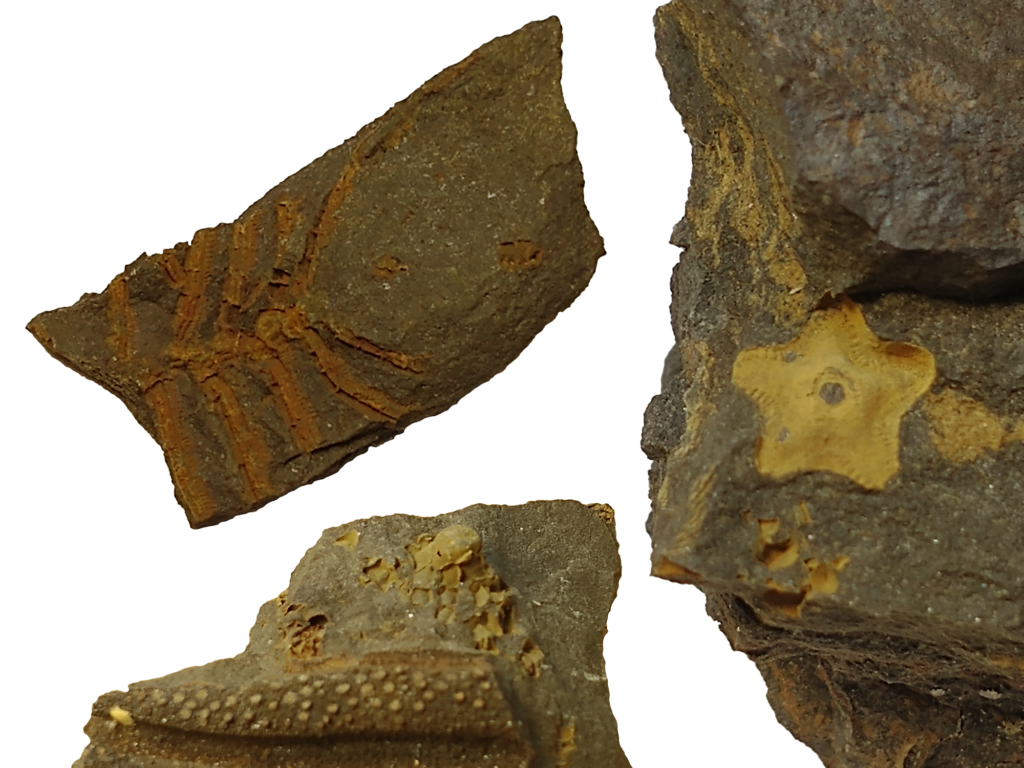
Crinoidea indet.
Many Crinoid columnals of uncertain identification have been found at Seven Stars. The diversity of these columnals indicates that there were several more genera of Crinoids at Seven Stars than can be identified with certainty. Sometimes, Crinoid columnals are scattered across the surface of a rock, forming a hashplate. Other times, more rarely, an articulated stem can be found, often with cirri branching off at regular intervals.
Rarely, a calyx of uncertain identification may turn up, like the one pictured at right. Crinoid calyxes offer a much bigger chance of reliable identification, so if you find one, compare it to the pictures in this paper about the Crinoids of New York (New York’s Middle Devonian fauna was very similar to that of Pennsylvania, with a few of the same formations).
To the right are a small, unidentified crinoid calyx and a large, spiny columnal.
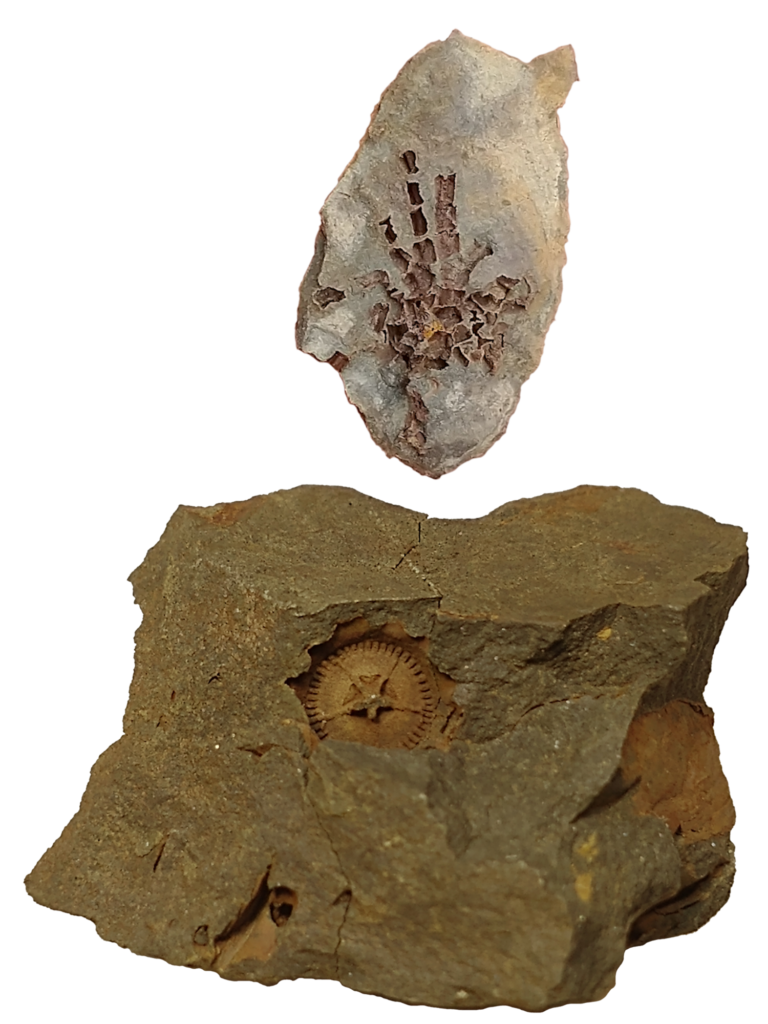
Works cited
(1) Rupert, Edward, and Barnes, Robert. (1994). Invertebrate Zoology. 6th ed., Fort Worth : Saunders College Pub. pp. 975–83, Accessed 14 July 2023. https://archive.org/details/invertebratezool0006rupp/mode/2up
(2) Hess, Hans & Ausich, William & Brett, Carlton & Simms, Michael. (2003). Fossil Crinoids. pp. 292. ISBN 0521524407. Cambridge, UK: Cambridge University Press, 15. 10.1017/CBO9780511626159.003. https://assets.cambridge.org/052145/0241/sample/0521450241ws.pdf
(3) McIntosh, George C., and Richard L. Schreiber. (1971). MORPHOLOGY AND TAXONOMY OF THE MIDDLE DEVONIAN CRINOID ANCYROCRINUS BULBOSUS HALL 1862. THE UNIVERSITY OF MICHIGAN, pp. 381–403 https://deepblue.lib.umich.edu/bitstream/handle/2027.42/48467/ID316.pdf;sequence=2
(4) Kesling, Robert V. (1973). NEW BOTRYOCRZNUS AND GLOSSOCRINUS FROM THE MIDDLE DEVONIAN BELL SHALE OF MICHIGAN. THE UNIVERSITY OF MICHIGAN, pp. 31–46. https://deepblue.lib.umich.edu/bitstream/handle/2027.42/48472/ID322.pdf?sequence=2
(5) Plotnick, Roy. (2014). Crinoids aweigh: Experimental biomechanics of Ancyrocrinus holdfasts. https://www.researchgate.net/publication/262450880_Crinoids_aweigh_Experimental_biomechanics_of_Ancyrocrinus_holdfasts
(6) Ferrario, Cinzia & Sugni, Michela & Somorjai, Ildiko & Ballarin, Loriano. (2020). Beyond Adult Stem Cells: Dedifferentiation as a Unifying Mechanism Underlying Regeneration in Invertebrate Deuterostomes. Frontiers in Cell and Developmental Biology. 8. 10.3389/fcell.2020.587320. https://www.researchgate.net/publication/345780098_Beyond_Adult_Stem_Cells_Dedifferentiation_as_a_Unifying_Mechanism_Underlying_Regeneration_in_Invertebrate_Deuterostomes
(7) Baumiller, Tomasz. (2003). Evaluating the interaction between platyceratid gastropods and crinoids: A cost-benefit approach. Palaeogeography. 201. 10.1016/S0031-0182(03)00625-4. https://www.researchgate.net/publication/262899849_Evaluating_the_interaction_between_platyceratid_gastropods_and_crinoids_A_cost-benefit_approach
(8) (2005). v01_id240_con_crianat.jpg. Animal Diversity Web. https://animaldiversity.org/collections/contributors/Grzimek_inverts/Crinoidea/v01_id240_con_crianat/
(9) Saulsbury, J. and Zamora, S. (2020). The nervous and circulatory systems of a Cretaceous crinoid: preservation, palaeobiology and evolutionary significance. Palaeontology, 63, 243– 253. https://deepblue.lib.umich.edu/bitstream/handle/2027.42/154347/pala12452.pdf?sequence=1
(10) Goldring, Winifred. (1923). The Devonian Crinoids of the State of New York. Albany : University of the State of New York. https://archive.org/details/devoniancrinoids00gold/page/484/mode/2up?ia=web
This image was used in the reconstruction of the digestive system in Crinoids with long anal tubes, but was not referenced in the text.
https://ucmp.berkeley.edu/echinodermata/morph.gif


